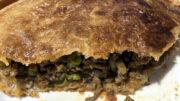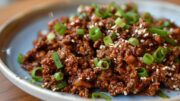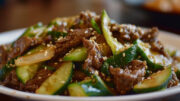Korean doenjang, a fundamental ingredient in Korean cuisine, offers a robust and savory flavor profile that enriches a variety of dishes. This traditional soybean paste has deep roots in Korean history and continues to be a staple in both traditional and modern cooking.
Doenjang, which translates to “thick paste,” has been a part of Korean culinary culture for centuries. Its origins can be traced back to ancient times, with historical records indicating its use during the Three Kingdoms period (57 BC – 668 AD). Initially, doenjang was made by fermenting soybeans and grains, a practice influenced by early agricultural methods and the necessity of preserving food.
The fermentation process, honed over generations, involves boiling soybeans, mashing them, and then fermenting the mixture in earthenware jars, called onggi. These jars are left to age for months or even years, allowing the flavors to develop and deepen. Traditionally, families would prepare large batches of doenjang, storing them in these jars to be used throughout the year. This fermentation technique not only preserved the soybeans but also enhanced their nutritional value, creating a rich, umami-packed paste.
Doenjang is celebrated for its versatility and depth of flavor. It serves as the backbone of many traditional Korean dishes, adding a savory, umami-rich element. One of the most iconic uses of doenjang is in doenjang jjigae, a hearty soybean paste stew filled with vegetables, tofu, and sometimes meat or seafood. This comforting dish showcases the rich, fermented flavors of doenjang, making it a beloved staple in Korean households.
Beyond jjigae, doenjang is used to flavor a variety of soups, stews, and marinades. It pairs exceptionally well with grilled meats, enhancing dishes like samgyeopsal (grilled pork belly) when mixed into dipping sauces. Doenjang is also a key ingredient in ssamjang, a thick dipping sauce used for wrapping grilled meats in lettuce or perilla leaves, adding a burst of savory flavor.
Versatility and Pairings
Doenjang’s versatility extends to its pairing with various ingredients. It complements vegetables, meats, and seafood, making it an essential ingredient in both vegetarian and non-vegetarian dishes. In vegetarian cuisine, doenjang is often used to add depth to dishes like bibimbap (mixed rice with vegetables) and namul (seasoned vegetable side dishes).
Modern Korean cuisine continues to innovate with doenjang, incorporating it into fusion dishes and new culinary creations. Chefs and home cooks alike experiment with doenjang-based sauces, dressings, and even desserts, pushing the boundaries of its traditional uses.
Storage and Availability
When purchasing doenjang, look for it in the refrigerated section of Asian grocery stores, where it is often sold in tubs or jars. Fresh, high-quality doenjang should have a rich, earthy aroma and a smooth, thick consistency. For optimal storage, keep doenjang in an airtight container in the refrigerator. It can last for several months, or even longer, if stored properly, as the fermentation process continues to preserve its flavors over time.
Popular doenjang brands are readily available in most Asian markets, ensuring that this essential ingredient is accessible to those looking to explore Korean cuisine. Sometimes there maybe no English markings on the items in the Asian market, fortunately doenjang can be identified by its brown container, where a gochujang container will be red and a ssamjang container will be green. Incorporating doenjang into your cooking can bring a taste of Korea’s rich culinary heritage into your home.





